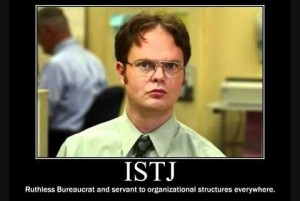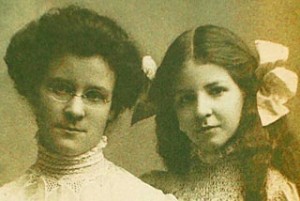By Juliet Wagner (Regular Contributor)
The scenario is not unfamiliar: beloved daughter leaves for college and returns for Christmas vacation with less than loveable boyfriend. Sure enough, they soon announce their engagement. What is a mother to do?
Katharine Briggs and Isabel Myers
When Katharine Briggs’ only daughter Isabel brought home Clarence Myers from Swarthmore College in the late 1910s, Briggs responded with remarkable empathy and characteristic bookishness: she created a theory of personality types to help her understand why her future son-in-law was so “different”.
Briggs was born in 1875 and although she was educated in a progressive home and attended agricultural college, cultural expectations prevented her from pursuing her interest in psychology professionally, and she instead became a passionate amateur, practicing her theories of educational psychology and childrearing on her one surviving child, Isabel. Whatever motivated Isabel’s tendentious choice of husband, her mother’s response to him led to an early vision of personality types that –inspired by Karl Jung’s model—became the basis for the now ubiquitous Myers-Briggs Type Indicator.
Mostly Bunk, but sTill In vogue
 It seems that Isabel Myers was not initially as enthused by her mother’s project, but once her own children were older, she began to build on Briggs studies, motivated especially by a desire to contribute to the war effort. In 1942, Myers began working for Edward M. Hay, the personnel manager of a Philadelphia bank, in order to learn to use existing career allocation tests. She was frustrated by their inefficacy, however, and began to design paper tests herself, based on her mother’s research on “type”. She continued to work on refining the questions and taking opportunities to test people, making the most of her father’s contacts in the academic world and Hay’s in the business world to secure access to ever-larger groups of test subjects. In 1962, the MBTI was published by Education Testing Service (ETS), for research use. In 1975, Myers contracted with Consulting Psychologists Press Inc. (CPP), who marketed the “indicator” for general use as a personality and career guide, launching the phenomenon we know today.
It seems that Isabel Myers was not initially as enthused by her mother’s project, but once her own children were older, she began to build on Briggs studies, motivated especially by a desire to contribute to the war effort. In 1942, Myers began working for Edward M. Hay, the personnel manager of a Philadelphia bank, in order to learn to use existing career allocation tests. She was frustrated by their inefficacy, however, and began to design paper tests herself, based on her mother’s research on “type”. She continued to work on refining the questions and taking opportunities to test people, making the most of her father’s contacts in the academic world and Hay’s in the business world to secure access to ever-larger groups of test subjects. In 1962, the MBTI was published by Education Testing Service (ETS), for research use. In 1975, Myers contracted with Consulting Psychologists Press Inc. (CPP), who marketed the “indicator” for general use as a personality and career guide, launching the phenomenon we know today.
As this brief sketch of its origins betrays, the MBTI is not based on orthodox scientific experiment, but rather on intuition and observation. It is now broadly dismissed in scientific circles. This skepticism notwithstanding, the MBTI remains tenaciously popular, especially in business and consulting settings, where some use their four-letter code as an introductory icebreaker (“Hi! I’m Clarence. ISTJ”). Cynics explain its popularity as a corollary of its flattery: by design, it describes a personality the test-taker wants to see reflected back, with the added legitimacy of a recognized trademark. A more charitable explanation is that it does serve as a useful shorthand for working styles (moods?) on first meeting (simpler than “Hi! I’m Juliet. Hung-over, impatient, cranky, cantankerous and underpaid” – HICCUP?).
Alas, there is still no scientifically approved method to understand difficult son-in-laws.
—-
There are many articles (and one book) on the history of Katherine Briggs, Isabel Myers and the MBTI, but by far the best read –and the most informative—is Merve Emre’s recent article:

